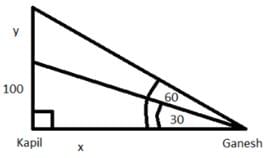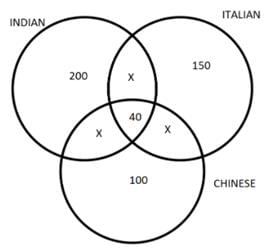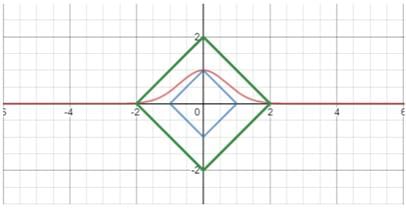Practice Test for IIFT - 2 - CAT MCQ
30 Questions MCQ Test - Practice Test for IIFT - 2
Rectangle TEHF has dimensions 15 m by 30 m, as shown. Tom the Cat begins at T, and Jerry the Mouse begins at J, the midpoint of TE. Jerry runs at 3 m/s in a straight line towards H. Tom starts at the same time as Jerry, and, running at 5 m/s in a straight line, arrives at point C at the same time as Jerry. The time, in seconds, that it takes Tom to catch Jerry is closest to
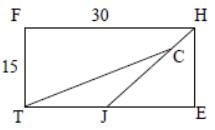

A milkman saves milk in two vessels, a cuboidal and the other a cylindrical. The capacity of the cuboidal vessel is 20 litres more than the cylindrical one. When 30 litres of milk is drawn from each of the two full vessels, the amount left in the cuboidal vessel is twice that left in the cylindrical vessel. The capacity (in litres) of the cuboidal vessel is
| 1 Crore+ students have signed up on EduRev. Have you? Download the App |
A larger cube is formed from the material obtained by melting three smaller cubes of 3, 4 and 5 cm side. The ratio of the total surface areas of the smaller cubes and the larger cube is
An ant starts from point A and covers all the paths to reach point D. What is the Minimum total distance travelled by the ant, if paths AB, BC, CD and DA act as diameters for respective semicircular paths?
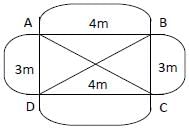
In a school 30% students are above 5 ft tall. Out of the remaining students, 60% are boys and remaining are girls whereas the percentage reverses in the above 5 ft group. Find the ratio of boys who are above 5 ft tall to the boys below 5 ft.?
A student took five papers in an examination, where full marks were same for each paper. Her marks in these papers were in the proportion of 6 : 7 : 8 : 9 : 10. In all these papers together, the candidate obtained 60 % of the total marks. Then the number of papers in which she got more than 50% marks is
DIRECTIONS for the question: Mark the best possible option.
A person can row 7.5 km an hour in still water and he finds that it takes him twice as long to row up as compared to row down the river. The rate of the stream is
There are 12 towns grouped into four zones with three towns per zone. It is intended to connect the towns with telephone lines such that every two towns are connected with three direct lines if they belong to the same zone, and with only one direct line otherwise. How many direct telephone lines are required?
At what time between 8 and 9 pm will the hands of a clock be making an angle of 180 degrees?
In an examination of n questions, a student answered 15 of the first 20 correctly. Of the remaining questions he answered one-third correctly. All the questions have the same credit. If the students scored 50% marks, how many different values of n can be there (no negative marking)?
Flight A and B with equal capacity are scheduled to take off from an airport. Passengers are waiting in a hall of capacity 200. The hall is currently having 10% of the seats unoccupied. 40 % of the waiting passengers are ladies. Both the flights put together have a total capacity equal to 2/3 rd of the total passengers who are waiting. Half the passengers who board flight A are women. After the boarding of flight A, 60% of the seats in the hall are empty. For every 20 passengers now in the hall, there is an airhostess in flight A. What is the ratio of empty seats in Flight B to the number of airhostesses in flight A?
A fruit seller sells an apple, an orange, a mango and a peach at loss of 10%, loss of 40%, profit of 20% and profit of 50% respectively. Let the loss made on an apple and an orange together be as much as in amount as the profit made on a mango and a peach together. Suppose you have the money to buy one apple and four oranges. But instead you buy five peaches. How many mangoes can you buy with the rest of the money?
If x,y,z are positive real numbers, find the value of x + y / z if 28 x 332 x 32 x 7(x + y + z) + 323 + 519 = 24 x 3y3 x 2x2 x 25 x 324 x 78 x 5z2 + 1.
In a trapezium, it was found that the sum of the squares of the diagonals is less than the sum of the squares of the sides by 196. If the shorter of the parallel sides is 8cm, what is the length of the longer of the parallel sides?
If α and β are the roots of the equation x2 + 5x + 3 = 0, then (α + 3/α + 3)3 + (β + 3/β + 1)3 = ?
Ram and Shyam went out shopping one day. A gift store had an object which was offered at 16.66% discount, was also marked 1.5 times its actual cost. Ram bought it and paid 40 rupees more than Shyam's whole day expense which was Rs 460. What was the cost price of the object?
How many 3 digit numbers, with digits a,b,c in the hundreds, tens and units place respectively, are there such that a < b < c ?
Ganesh and Kapil went for an adventure that included a vertical flight from a point on the ground. Ganesh took the photos of Kapil while he was flying. He stood some meters away from Kapil at the time of Kapil's flight. Kapil started flying up at a constant speed. Ganesh captured his two photos when Kapil was at angles of 30 and 60 degree w.r.t ground. In the first photo, Kapil was 100 meters up from the ground but his elevation in his later photo was not known. But it is known that time gap in both the photos was 20 seconds. What was the speed at which Kapil was going up?
A food study based on a multi-cultural society of 1000 people was carried and the people were asked to choose at most 3 out of Indian, Italian and Chinese food. 450 people who liked only 1 type of food were distributed among Indian, Italian and Chinese in the ratio 4 : 3 : 2. People who liked all and none were 40 and 300 respectively. If people who liked exactly 2 food types were symmetrically distributed, how many people liked exactly Indian and Chinese ?
One man travels 180 kilometres in a motorboat from Mathura to Delhi with the flow of the river and comes back the next day against the flow of the river. What is the speed of flow, if it takes 2.4 hours more while coming back? (assume speed of motorboat = 40 km/hr)
A water tank has 2 inlet and 1 outlet pipe attached to it. Inlet pipes individually require 5 and 10 hours respectively to fill the tank and outlet pipe requires 4 hours to empty the full tank. All pipes were opened for 15 hours. Later outlet pipe and smaller inlet pipe were closed. How much more time is required to fill the tank completely?
If no of points of intersection of e-x2 with ∣x∣ + ∣y∣ = 1 and ∣x∣ + ∣y∣ = 2 are a and b respectively. What is the value of a + b?
If three friends A, B and C invested Rs 10000, Rs 12000, Rs 15000 respectively at rates 10%, 5%, and 8% respectively for 2 years. After 2 years, A added Rs 4000 to his total sum, B took out all his money and C withdrew Rs 7400 from his total sum. All the rates were constant in 3rd year too. What is their ratio of profit after 3 years?
P(x, y) = x2 + y2 + 3x2y + 3xy2 and Q(x,y) = x2 − y + x2y − x. Find Q(4, P(2, 3))
DIRECTIONS for the question : Read the passage and answer the question based on it.
I could tolerate and indeed liked a somewhat higher level of noise and activity in my class. But this posed me a problem. I wanted to give children plenty of chance to talk to each other and enjoy each other's company. But children are excitable and tend to get carried away. I needed a way to control the noise. So I invented the Q. So when I wanted quiet I would write a capital Q in a corner of the blackboard. When it was up, the standard school rule went into effect: no talking unless you raise your hand and get permission.
When I first put the Q on the board, in the corner, I drew a little box around it. Children being great lawyers, they began to argue that the Q was not officially on the board until the box had been drawn. I agreed to that. And then, slowly, the children invented or developed a delightful custom. When I began to write the Q they would all make some kind of hum or murmur or sound, which would get louder and louder, rising to a shriek as I boxed in the Q with a flourish. But as soon as my chalk hit the edge of the blackboard, completing the box, dead silence. Now and then I wondered, whether I ought to take some steps about that pre-Q shriek. But I didn't. In the first place, I loved it; in the second place, I realized, at first intuitively, later with much thought, that the shriek was part of what made the Q work--and it worked very well. It was the children's way of making that Q theirs as well as mine, and because it was theirs as well as mine, they respected it.
Only once did the children test the Q. One day when the Q was up, some of the bolder students, including some of my special favorites, began to talk a lot. I began frantically writing down marks. Other children saw what was happening, and began to talk as well. Mutiny! The game began to be, see how fast we can make Mr. Holt write down marks. I stopped everything and gave the class a little speech, about like this: "Look, everyone, I know what's happening here. You're trying to find out whether you can wreck the Q system, and the answer is, of course you can. It only works because basically you think it's a pretty fair and sensible system and are willing to let it work. The only thing is, if we lose the Q system, what are we going to put in its place? I'll have to control it the way the other teachers try to, which is not to let you talk at all."
Q. What would have been the behaviour change of the kids after listening to the sermon of the last paragraph?
DIRECTIONS for the question: Read the passage and answer the question based on it.
I could tolerate and indeed liked a somewhat higher level of noise and activity in my class. But this posed me a problem. I wanted to give children plenty of chance to talk to each other and enjoy each other's company. But children are excitable and tend to get carried away. I needed a way to control the noise. So I invented the Q. So when I wanted quiet I would write a capital Q in a corner of the blackboard. When it was up, the standard school rule went into effect: no talking unless you raise your hand and get permission.
When I first put the Q on the board, in the corner, I drew a little box around it. Children being great lawyers, they began to argue that the Q was not officially on the board until the box had been drawn. I agreed to that. And then, slowly, the children invented or developed a delightful custom. When I began to write the Q they would all make some kind of hum or murmur or sound, which would get louder and louder, rising to a shriek as I boxed in the Q with a flourish. But as soon as my chalk hit the edge of the blackboard, completing the box, dead silence. Now and then I wondered, whether I ought to take some steps about that pre-Q shriek. But I didn't. In the first place, I loved it; in the second place, I realized, at first intuitively, later with much thought, that the shriek was part of what made the Q work--and it worked very well. It was the children's way of making that Q theirs as well as mine, and because it was theirs as well as mine, they respected it.
Only once did the children test the Q. One day when the Q was up, some of the bolder students, including some of my special favorites, began to talk a lot. I began frantically writing down marks. Other children saw what was happening, and began to talk as well. Mutiny! The game began to be, see how fast we can make Mr. Holt write down marks. I stopped everything and gave the class a little speech, about like this: "Look, everyone, I know what's happening here. You're trying to find out whether you can wreck the Q system, and the answer is, of course you can. It only works because basically you think it's a pretty fair and sensible system and are willing to let it work. The only thing is, if we lose the Q system, what are we going to put in its place? I'll have to control it the way the other teachers try to, which is not to let you talk at all."
Q. Based on a reading of the passage, complete the following:
Later, realizing that much of the time what I wanted was quiet, not silence, I modified the Q.
DIRECTIONS for the question: Read the passage and answer the question based on it.
I could tolerate and indeed liked a somewhat higher level of noise and activity in my class. But this posed me a problem. I wanted to give children plenty of chance to talk to each other and enjoy each other's company. But children are excitable and tend to get carried away. I needed a way to control the noise. So I invented the Q. So when I wanted quiet I would write a capital Q in a corner of the blackboard. When it was up, the standard school rule went into effect: no talking unless you raise your hand and get permission.
When I first put the Q on the board, in the corner, I drew a little box around it. Children being great lawyers, they began to argue that the Q was not officially on the board until the box had been drawn. I agreed to that. And then, slowly, the children invented or developed a delightful custom. When I began to write the Q they would all make some kind of hum or murmur or sound, which would get louder and louder, rising to a shriek as I boxed in the Q with a flourish. But as soon as my chalk hit the edge of the blackboard, completing the box, dead silence. Now and then I wondered, whether I ought to take some steps about that pre-Q shriek. But I didn't. In the first place, I loved it; in the second place, I realized, at first intuitively, later with much thought, that the shriek was part of what made the Q work--and it worked very well. It was the children's way of making that Q theirs as well as mine, and because it was theirs as well as mine, they respected it.
Only once did the children test the Q. One day when the Q was up, some of the bolder students, including some of my special favorites, began to talk a lot. I began frantically writing down marks. Other children saw what was happening, and began to talk as well. Mutiny! The game began to be, see how fast we can make Mr. Holt write down marks. I stopped everything and gave the class a little speech, about like this: "Look, everyone, I know what's happening here. You're trying to find out whether you can wreck the Q system, and the answer is, of course you can. It only works because basically you think it's a pretty fair and sensible system and are willing to let it work. The only thing is, if we lose the Q system, what are we going to put in its place? I'll have to control it the way the other teachers try to, which is not to let you talk at all."
Q. In the first paragraph, when the author qualifies the school rule with the adjective standard, which of the following standard dictionary definitions would fit the meaning best?
DIRECTIONS for the question: Read the passage and answer the question based on it.
The UN Intergovernmental Panel on Climate Change (IPCC) recently issued a report that said, “Greenhouse gas forcing has very likely (>90 percent) caused most of the observed global warming over the last 50 years.” Many climate doubters and global warming deniers have raised some serious questions about the 90 percent figure.
Due to these doubts, government representatives were allowed to vote on and revise the IPCC summaries, no matter what the data said. As a direct result, China (think coal) and Saudi Arabia (oil) got to veto anything they didn't like. The United States (think do nothing) also had line-by-line veto power.. The deniers call this “politicized Science” and say that the IPCC summaries were just one big, exaggeration, when in fact the reverse is true. They are at most surely understated. It would be like giving a convicted thief a say over the wording of the laws that govern theft. You can bet the final text would go light on thievery. So goes the politicized UN Intergovernmental Panel on Climate Change. While politicized science (an oxymoron if there ever was one) is watered down and conveniently misleading, the real science of global climate change is well understood, and its acceptance in the rigorous world of peer- reviewed science is all but universal. How does global warming work? Well, it can be explained in a simple way.
Certain gases carbon dioxide (CO2), nitrogen oxide (N2O), methane,(CH4), and chlorofluorocarbons (CFC) of all kinds--act like blankets thrown across the globe. They trap heat near the earth’s surface. As atmospheric concentrations of these gases increase, the blanket thickens and global temperatures increase. Business, industry, and you and I and everyone else emit about nine billion tons of carbon into the air each year, including the effect, of deforestation. We do it when we start our cars. We do it when we turn on our lights or burn coal to run a generating station. The earth can capture and sequester about 3.7 billion tons of anthropogenic carbon per year. The difference between what we emit mid what the earth can absorb is 9.0 – 3.7 = 5.3 billion tons excess carbon per year. That 5.3 billion tons goes into the atmosphere and stays there, increasing atmospheric concentrations of CO2 by 2 or 3 parts per million each year. Unchecked that CO2 will rise and pass that red line that our best scientists believe is out there in the vicinity of 450 pm, which will induce a global average temperature change of two degrees Centigrade (3.8 Fahrenheit). .
Also, the world’s oceans and forests are absorbing less of the CO2 released by human activity, adding to the faster rise in atmospheric levels of greenhouse gases. Deforestation is a two-edge sword, as sinks shrinks and CO2 releases from them increase. The ability of ocean to take up carbon decline with warming and acidification and CO2 in water yields carbonic acid, which also threatens any creature that makes a shell. Warming temperatures have prompted earlier springs in the far north and have caused plant species to spread farther into formerly, icy terrain. Meanwhile, summer sea ice in the Artic reached a record low this year. Through melting sea levels, larger expanses of blue Ocean reduce the earth’s albedo (its reflectivity), resulting in greater heat absorption. Also, as forests die and crop¬lands succumb to encroaching deserts, they too are taken of the board as carbon absorbers. As vast regions of tundra and permafrost warm melt they release enormous amount of methane - a greenhouse gas many times, more potent than simple carbon dioxide. Here's the takeaway message: Atmospheric concentrations will continue to increase until the gases we send into the air and the earth’s ability to absorb those gases come into balance.
If we have to sum up the situation, we are emitting nearly three times as much greenhouse gases as the earth is able to absorb. It should be obvious from those numbers that we cannot avoid crossing those red lines by planting more trees, because there simply is not enough Land. We must reduce our fossil fuel use to reduce the billions of excess tons of carbon we belch into Air. The crisis-climate change-is very real. That is why we, in the developed nations, need to get our act together on this, to show some real leadership, and to seize insurmountable opportunities. But before we can preach the gospel to the world, we need to put our own house in order. We must turn a deaf ear to the voices assuring us, ‘Everything will be fine, don’t worry! It’s all under control!’ That’s the sort of fatal message that kept card players at the tilting tables in the grand salon of the Titanic. Denial is deadly.
Q. Which of the following statements is false?
DIRECTIONS for the question: Read the passage and answer the question based on it.
The UN Intergovernmental Panel on Climate Change (IPCC) recently issued a report that said, “Greenhouse gas forcing has very likely (>90 percent) caused most of the observed global warming over the last 50 years.” Many climate doubters and global warming deniers have raised some serious questions about the 90 percent figure.
Due to these doubts, government representatives were allowed to vote on and revise the IPCC summaries, no matter what the data said. As a direct result, China (think coal) and Saudi Arabia (oil) got to veto anything they didn't like. The United States (think do nothing) also had line-by-line veto power.. The deniers call this “politicized Science” and say that the IPCC summaries were just one big, exaggeration, when in fact the reverse is true. They are at most surely understated. It would be like giving a convicted thief a say over the wording of the laws that govern theft. You can bet the final text would go light on thievery. So goes the politicized UN Intergovernmental Panel on Climate Change. While politicized science (an oxymoron if there ever was one) is watered down and conveniently misleading, the real science of global climate change is well understood, and its acceptance in the rigorous world of peer- reviewed science is all but universal. How does global warming work? Well, it can be explained in a simple way.
Certain gases carbon dioxide (CO2), nitrogen oxide (N2O), methane,(CH4), and chlorofluorocarbons (CFC) of all kinds--act like blankets thrown across the globe. They trap heat near the earth’s surface. As atmospheric concentrations of these gases increase, the blanket thickens and global temperatures increase. Business, industry, and you and I and everyone else emit about nine billion tons of carbon into the air each year, including the effect, of deforestation. We do it when we start our cars. We do it when we turn on our lights or burn coal to run a generating station. The earth can capture and sequester about 3.7 billion tons of anthropogenic carbon per year. The difference between what we emit mid what the earth can absorb is 9.0 – 3.7 = 5.3 billion tons excess carbon per year. That 5.3 billion tons goes into the atmosphere and stays there, increasing atmospheric concentrations of CO2 by 2 or 3 parts per million each year. Unchecked that CO2 will rise and pass that red line that our best scientists believe is out there in the vicinity of 450 pm, which will induce a global average temperature change of two degrees Centigrade (3.8 Fahrenheit). .
Also, the world’s oceans and forests are absorbing less of the CO2 released by human activity, adding to the faster rise in atmospheric levels of greenhouse gases. Deforestation is a two-edge sword, as sinks shrinks and CO2 releases from them increase. The ability of ocean to take up carbon decline with warming and acidification and CO2 in water yields carbonic acid, which also threatens any creature that makes a shell. Warming temperatures have prompted earlier springs in the far north and have caused plant species to spread farther into formerly, icy terrain. Meanwhile, summer sea ice in the Artic reached a record low this year. Through melting sea levels, larger expanses of blue Ocean reduce the earth’s albedo (its reflectivity), resulting in greater heat absorption. Also, as forests die and crop¬lands succumb to encroaching deserts, they too are taken of the board as carbon absorbers. As vast regions of tundra and permafrost warm melt they release enormous amount of methane - a greenhouse gas many times, more potent than simple carbon dioxide. Here's the takeaway message: Atmospheric concentrations will continue to increase until the gases we send into the air and the earth’s ability to absorb those gases come into balance.
If we have to sum up the situation, we are emitting nearly three times as much greenhouse gases as the earth is able to absorb. It should be obvious from those numbers that we cannot avoid crossing those red lines by planting more trees, because there simply is not enough Land. We must reduce our fossil fuel use to reduce the billions of excess tons of carbon we belch into Air. The crisis-climate change-is very real. That is why we, in the developed nations, need to get our act together on this, to show some real leadership, and to seize insurmountable opportunities. But before we can preach the gospel to the world, we need to put our own house in order. We must turn a deaf ear to the voices assuring us, ‘Everything will be fine, don’t worry! It’s all under control!’ That’s the sort of fatal message that kept card players at the tilting tables in the grand salon of the Titanic. Denial is deadly.
Q. Why has ‘politicized science’ been referred to as an oxymoron?


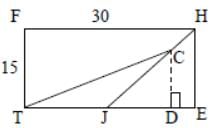

 Solving it we get 16t2 = 225 + 45√2t
Solving it we get 16t2 = 225 + 45√2t


